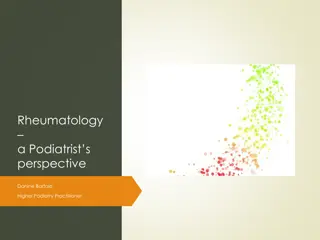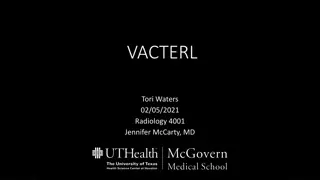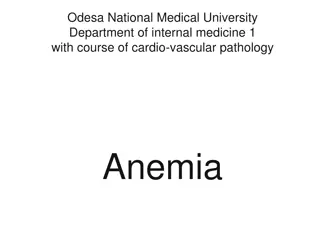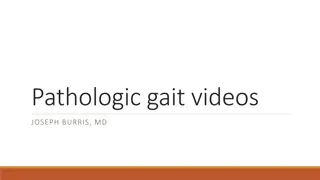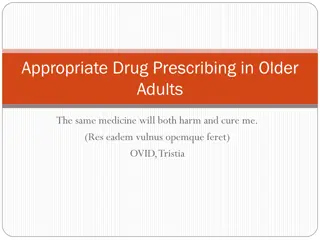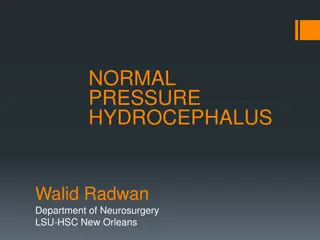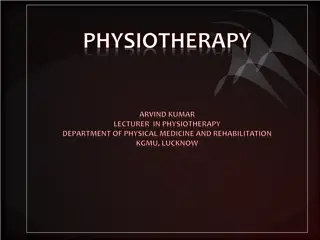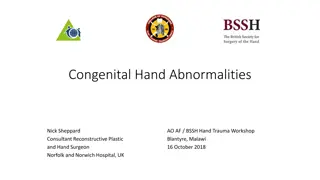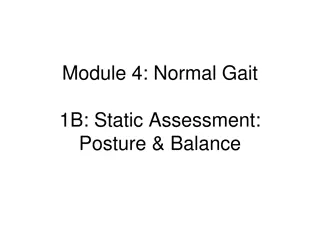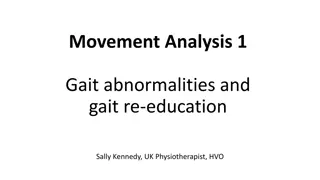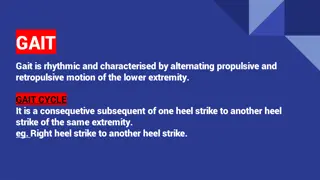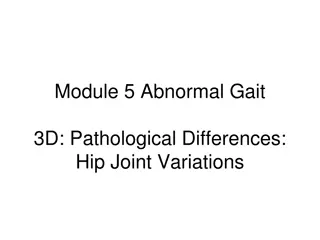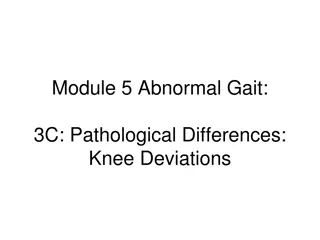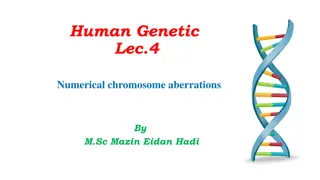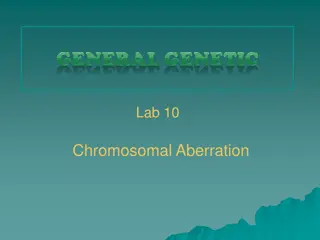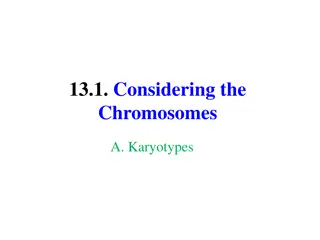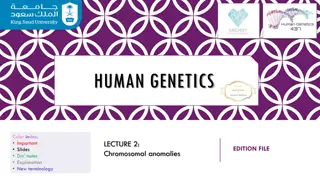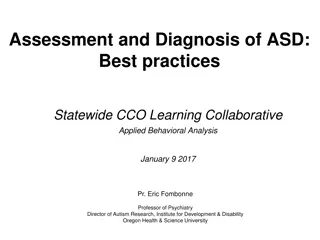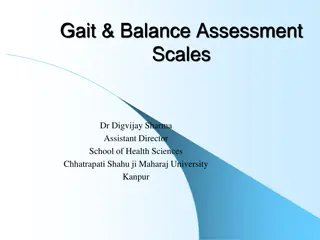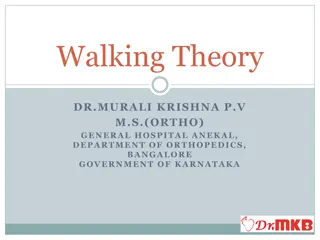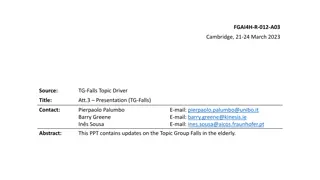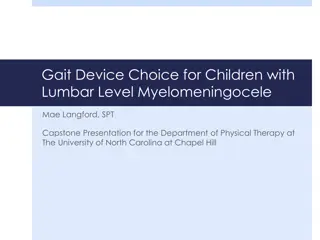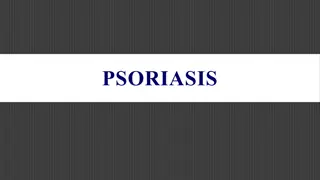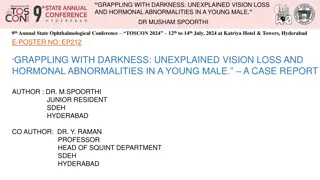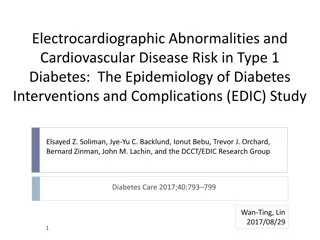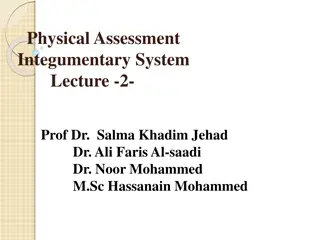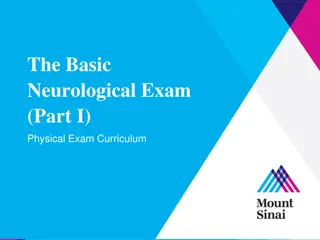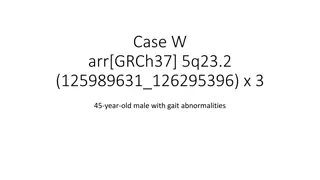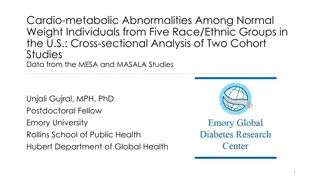Musculoskeletal System Assessment Guidelines
Learn how to conduct a thorough musculoskeletal system assessment, including functional assessments and physical examination guidelines. Explore assessment techniques for ADLs, gait observation, joint palpation, muscle strength testing, and more in nursing practice.
1 views • 17 slides
PHYSIOTHERAPY IN KNEE JOINT INJURIES
Explore the anatomy of the knee joint, common knee injuries like meniscus tears and ACL ruptures, and the role of physiotherapy in treatment and rehabilitation. Learn about exercises, gait training, and post-surgical care for knee injuries.
2 views • 12 slides
Podiatrist's Role in Managing Foot Involvement in Rheumatic Diseases
Rheumatology encompasses over 200 conditions affecting the musculoskeletal system, with foot involvement being significant in conditions like RA and OA. Podiatrists play a crucial role in diagnosing, treating, and preventing foot problems associated with inflammatory arthritis, such as joint damage,
0 views • 20 slides
Case Study: VACTERL Association in a Newborn Female with Imperforate Anus
Newborn female with VACTERL association, imperforate anus, and perianal skin tag identified at birth. Patient transferred for surgical intervention and further workup due to associated abnormalities. Imaging studies show multiple sacral vertebral anomalies. Differential diagnosis includes genetic sy
0 views • 16 slides
Comprehensive Overview of Morse Fall Scale and Its Application in Preventing Falls
Falls among hospitalized patients pose a significant risk, with 30-50% resulting in injuries. The Morse Fall Scale (MFS) is a widely used method to assess fall risk, comprising six variables with predictive validity. Factors such as history of falling, ambulatory aids, gait, and mental status are cr
0 views • 13 slides
Understanding Red Blood Cell Abnormalities in Anemia: A Detailed Overview
This in-depth article delves into the various types of red blood cell abnormalities seen in anemia, such as anisocytosis, poikilocytosis, spherocytes, ovalocytes, acanthocytes, codocytes, drepanocytes, and stomatocytes. It explains the characteristics of each abnormality, their significance in diffe
0 views • 45 slides
Comprehensive Guide to Acute Knee Examination in Urgent Care
This detailed guide covers the essential components of the acute knee exam conducted in an urgent care setting by Dr. Gregory Jones, including chief complaints, anatomy, examination techniques, ligament assessments, practical aspects, and more. The examination process involves assessing functional l
1 views • 27 slides
Overview of Pathologic Gait Patterns for Clinical Reference
Explore a comprehensive collection of videos and images demonstrating various pathologic gait patterns exhibited in patients with different lower extremity weaknesses and neurological conditions. From steppage gait to Parkinsonian gait, each video provides a visual insight into the distinct characte
0 views • 19 slides
Understanding Karyotypes and Chromosomal Abnormalities
Karyotypes are photographic inventories of an individual's chromosomes, helping determine genetic sex and detect abnormalities. Common chromosomal conditions like Down syndrome, Klinefelter's syndrome, and Turner's syndrome are discussed, along with the impact of abnormal sex chromosomes on characte
0 views • 10 slides
Understanding Azoturia in Horses: Causes, Symptoms, and Treatment
Azoturia, also known as exertional rhabdomyolysis or tying-up syndrome, is a multifactorial myopathy that mainly affects draft horses. It is characterized by stiffness in gait, reluctance to move, lameness, and myoglobinuria. The disease typically occurs during exercise after a period of rest and ca
0 views • 14 slides
Appropriate Drug Prescribing in Older Adults: Balancing Harm and Cure
Understanding age-related changes in pharmacokinetics and pharmacodynamics is crucial for appropriate drug prescribing in older adults. Recognizing high-risk medications to avoid, understanding common drug interactions, and conducting regular drug list reviews are key components in providing safe an
1 views • 47 slides
Vocabulary Exploration Week 1: Words and Definitions
Dive into the world of vocabulary with Week 1's words and their meanings. Work with a partner to discuss terms like "swell," "aspect," "navigation," "submerge," "porthole," "anxiety," "cultural," "rampart," "tight-fisted," and "gait." Explore the nuances and applications of each word through engagin
0 views • 16 slides
Understanding Normal Pressure Hydrocephalus: Clinical Features and Diagnosis
Normal Pressure Hydrocephalus (NPH) is a condition characterized by the classic triad of dementia, urinary incontinence, and gait disturbance. Learn about the history, types, diagnostic studies, and presentation of NPH, along with differentiating it from other diseases. Discover the current standard
0 views • 30 slides
Introduction to Physiotherapy: Modalities and Exercise Therapy
Physiotherapy, a branch of medical science, utilizes various modalities like electric current, heat/cold, water, and exercises for therapeutic treatment. It includes exercise therapy with active and passive movements, electrotherapy, thermotherapy, hydrotherapy, and massage. Active movements involve
4 views • 42 slides
Understanding Congenital Hand Abnormalities and Associated Syndromes
Explore congenital hand abnormalities such as macrodactyly, trigger thumb, clasped thumb, preaxial deficiency, and syndromes like Holt-Oram Syndrome and Fanconi Anemia. Learn about assessment, intervention plans, and common treatments provided by experts in reconstructive plastic and hand surgery.
1 views • 26 slides
Portal Vein Imaging Techniques and Anomalies Overview
Portal vein imaging is crucial for evaluating conditions affecting the abdominal part of the gastrointestinal tract. Techniques such as spleno-portography and CT triphasic contrast imaging are used to visualize the portal vein and diagnose anomalies like portal-systemic collaterals and porto-systemi
4 views • 7 slides
Understanding Posture, Balance, and Gait Analysis in Human Movement
This resource delves into the static assessment of posture and balance, exploring the various inputs and control mechanisms involved in maintaining standing posture. It discusses the key factors influencing posture, such as visual, somatosensory, proprioceptive, and vestibular systems, along with mu
0 views • 51 slides
Comprehensive Guide to Neurological Examination in Dogs and Cats
Neurological examination in dogs and cats is crucial for diagnosing nervous system disorders. This guide covers the recording of history, general and detailed clinical examinations, examination of CSF, radiographic examination, EEG, and brain biopsy. It includes assessing history, mental state, move
0 views • 20 slides
Understanding Gait Abnormalities and Re-Education: A Comprehensive Analysis by Sally Kennedy
Sally Kennedy, a UK physiotherapist, explores gait abnormalities common in older individuals and those with neurological conditions. The content delves into the stages of the normal gait cycle, from initial contact to mid-swing, highlighting the importance of identifying and managing common gait pro
0 views • 21 slides
Understanding the Phases of Gait Cycle
Gait is a rhythmic motion of the lower extremities characterized by alternating propulsive and retropulsive movements. The Gait Cycle consists of Swing Phase and Stance Phase, each crucial for walking efficiency. Stance Phase is further divided into stages like Initial Contact, Loading Response, Mid
0 views • 20 slides
Pathological Differences in Hip Joint Variations: Abnormal Gait Analysis
Understanding pathological gait variations related to hip joint differences is crucial in gait analysis. Excessive sagittal, coronal, and transverse plane motions impact stance and swing phases, leading to deviations in gait patterns. Excess flexion, limited flexion, past retraction, excess adductio
0 views • 13 slides
Understanding Pathological Knee Variations in Gait Analysis
Explore different knee deviations in gait analysis, such as limited knee flexion, knee hyperextension, extensor thrust, and excess knee flexion. Learn how these deviations disrupt normal gait patterns, impact muscle demands, and affect shock absorption during various phases of the gait cycle.
1 views • 19 slides
Understanding Numerical Chromosome Aberrations in Humans
Numerical chromosome aberrations involve the gain or loss of whole chromosomes, impacting the genome size and potentially leading to genetic mutations. Nondisjunction, where chromosomes fail to separate properly during cell division, can result in aneuploidy - the presence of an extra or missing chr
0 views • 18 slides
Understanding Chromosomal Aberrations and Mutations in Genetics
Chromosomal aberrations and mutations are key events that can alter the genetic structure of organisms. They can lead to numerical abnormalities like aneuploidy and structural abnormalities such as ring chromosomes and chromosome fragments. Understanding these variations in chromosomes is crucial in
0 views • 10 slides
Understanding Chromosomal Abnormalities and Syndromes
Human cells have 22 pairs of autosomes and one pair of sex chromosomes, totaling 46. Karyotypes help diagnose chromosomal abnormalities by aligning chromosomes in size order. Nondisjunction during meiosis can lead to abnormal chromosome numbers in gametes. Disorders like Down Syndrome, XYY Syndrome,
0 views • 30 slides
Understanding Chromosomal Anomalies in Human Genetics
This lecture covers essential topics in human genetics, focusing on mitosis, meiosis, and chromosomal abnormalities. Students will learn about the events in mitosis and meiosis, non-disjunction, and classification of chromosomal anomalies, including numerical and structural abnormalities. Detailed e
1 views • 22 slides
Comprehensive Clinical Evaluation of Children with Cardiac Abnormalities
Initial clinical evaluation of a child with possible cardiac abnormalities includes history taking and physical examination. History should cover symptoms related to pulmonary and systemic venous congestion, cyanosis, cyanotic spells, palpitations, chest pain, and more. The general physical examinat
0 views • 65 slides
Understanding Autism Spectrum Disorder: Assessment, Diagnosis, and Characteristics
This content delves into the assessment and diagnosis of Autism Spectrum Disorder (ASD) with a focus on early markers, DSM-5 criteria, language/communication abnormalities, social interaction abnormalities, and repetitive behaviors/unusual interests. It provides a comprehensive overview of the key a
0 views • 20 slides
Understanding Gait and Balance Assessment in Elderly
Balance in elderly individuals is essential to prevent falls and injuries. Disorders of balance can lead to difficulties in posture maintenance, walking, and dizziness. Neural components play a crucial role in postural control, involving sensory processes, central processing, and effector components
0 views • 59 slides
Decoding the Dynamics of Walking: An In-depth Exploration
Walking is a fundamental yet complex phenomenon that plays a crucial role in our daily lives. Despite its significance, the science behind how we walk is often overlooked in education and healthcare. This article delves into the various aspects of walking, from muscle actions to gait analysis, shedd
0 views • 46 slides
Advances in Fall Risk Assessment and Management for Older Adults
This presentation delves into updates on the stratification tool for fall risk in community-dwelling older adults, emphasizing the importance of early intervention through opportunistic health visits. It discusses a decision tree model for assessing fall risk, highlighting the significance of histor
0 views • 12 slides
Gait Device Selection for Children with Lumbar Level Myelomeningocele
This presentation discusses the considerations and choices of gait devices for children with lumbar level myelomeningocele. It covers the specific needs of pediatric patients, benefits and drawbacks of various devices, funding requirements, and clinical application through case studies. The material
0 views • 31 slides
Understanding Psoriasis: Causes, Types, and Symptoms
Psoriasis is a chronic, multifactorial skin condition characterized by papulosquamous eruptions caused by abnormalities in arachidonic acid metabolism and skin cell immunity. It is believed to have a genetic component and results in various types of lesions like chronic plaque, guttate, flexural, an
0 views • 10 slides
Unexplained Vision Loss and Hormonal Abnormalities in Young Male - A Case Report
A case report presented at the 9th Annual State Ophthalmological Conference TOSCON 2024 discusses a young male patient grappling with unexplained vision loss and hormonal abnormalities. The patient exhibited symptoms of headache, diminished vision in the left eye, and an unusual head-turning behavio
0 views • 6 slides
Electrocardiographic Abnormalities and Cardiovascular Disease Risk in Type 1 Diabetes
This study examines the association between ECG abnormalities and incident CVD events in patients with type 1 diabetes, focusing on the prognostic significance in a population where CVD develops earlier. Major and minor ECG abnormalities were classified, with cardiovascular events such as myocardial
0 views • 16 slides
Understanding Genu Valgum: Causes, Symptoms, Diagnosis, and Treatment
Genu valgum, also known as knock knees, is characterized by inward angulation of the legs at the knee joint. This condition can arise from various factors such as rickets, growth imbalances, muscle weakness, injuries, and more. Symptoms include visual separation of the ankles, altered gait, and pote
0 views • 6 slides
Comprehensive Guide to Integumentary System Assessment Techniques
Learn the essential techniques for assessing the integumentary system, including skin, hair, and nails, through inspection and palpation. Understand how to evaluate nail health based on color, shape abnormalities like spoon shape or clubbing, and texture variations. Explore skin assessment criteria,
0 views • 21 slides
Comprehensive Guide to Neurological Exams
This guide provides a detailed overview of neurological exams, focusing on components such as cognition, motor function, and cranial nerves. It covers essential aspects like mental status, reflexes, sensation, and gait assessment. The importance of thorough examination in primary care settings is em
0 views • 29 slides
Evaluation of Genetic Abnormalities in a 45-Year-Old Male with Gait Abnormalities
A 45-year-old male with gait abnormalities was referred for evaluation, with an unknown inheritance and deceased parents. His father had a history of ataxia and tremor. Using the GAIN scoring metric, the genomic content was assessed, including the presence of protein-coding genes, established TS gen
0 views • 24 slides
Cardio-metabolic Abnormalities Among Normal Weight Individuals: A Cross-sectional Analysis of Race/Ethnicity in the U.S.
Overweight and obesity are known cardio-metabolic risk factors, but this study delves into abnormalities among normal-weight individuals. The research compares data from MESA and MASALA studies, including diverse race/ethnicity groups like White, African American, Hispanic American, Chinese American
1 views • 23 slides


